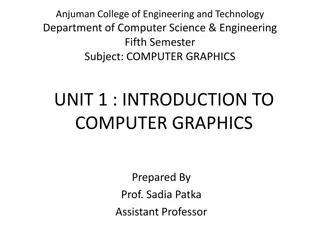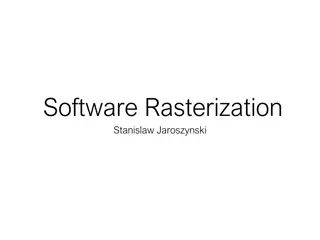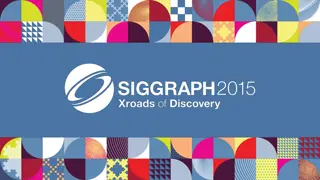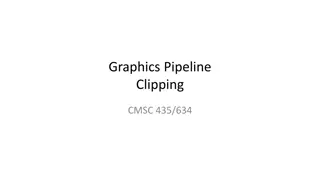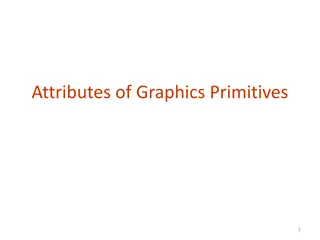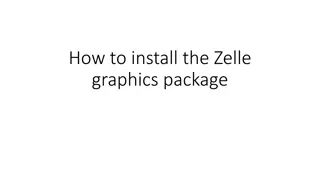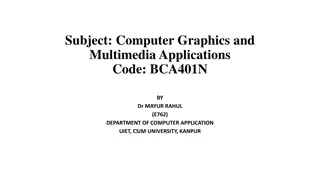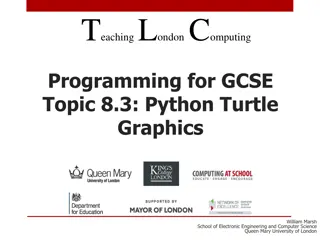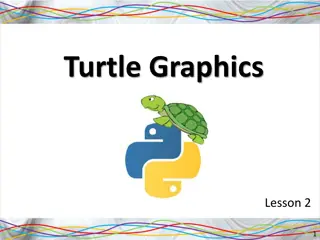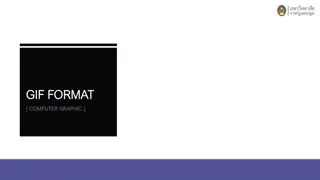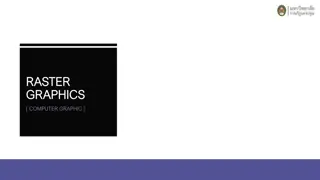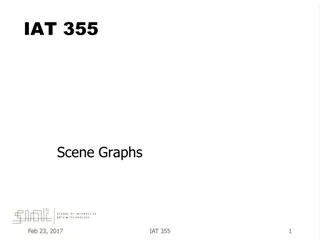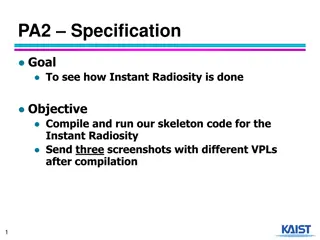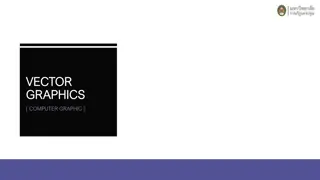Understanding Radiosity in Computer Graphics
Radiosity is a physically based method for modeling diffuse environments, handling interactions like color bleeding and indirect lighting. The technique involves solving equations, subdividing scenes, and computing constant illumination values for polygons. Radiosity provides a realistic global illumination solution by considering energy transfer and surface reflectivity. By following a specific algorithm, users can achieve visually appealing results in computer graphics simulations.
Download Presentation

Please find below an Image/Link to download the presentation.
The content on the website is provided AS IS for your information and personal use only. It may not be sold, licensed, or shared on other websites without obtaining consent from the author. Download presentation by click this link. If you encounter any issues during the download, it is possible that the publisher has removed the file from their server.
E N D
Presentation Transcript
CS580: Radiosity Sung-Eui Yoon ( ) Course URL: http://sglab.kaist.ac.kr/~sungeui/GCG
Class Objective Understand radiosity Radiosity equation Solving the equation 2
History Problems with classic ray tracing Not realistic View-dependent Radiosity (1984) Global illumination in diffuse scenes Monte Carlo ray tracing (1986) Global illumination for any environment 3
Radiosity Physically based method for diffuse environments Support diffuse interactions, color bleeding, indirect lighting and penumbra Account for very high percentage of total energy transfer Finite element method 4
Key Idea #1: Diffuse Only Radiance independent of direction Surface looks the same from any viewpoint No specular reflection 5
Diffuse Surfaces Diffuse emitter = constant over ) ( x L Diffuse reflector Constant reflectivity From kavita s slides 6
Key Idea #2: Constant Polygons Radiosity is an approximation Due to discretization of scene into patches Subdivide scene into small polygons 7
Constant Radiance Approximation Radiance is constant over a surface element L(x) = constant over x 8
Radiosity Equation + = Self-emitted radiosity Reflected radiosity Radiosity 9
Radiosity Algorithm Subdivide the scene in small polygons Compute a constant illumination value for each polygon Choose a viewpoint and display the visible polygon Keep doing this process From Donald Fong s slides 11
Linear System of Radiosity Equations 16
How to Solve Linear System Matrix inversion Takes O(n3) Gather methods Jacobi iteration Gauss-Seidel Shooting Southwell iteration 17
Iterative Approaches Jacobi iteration Start with initial guess for energy distribution (light sources) Update radiosity of all patches based on the previous guess Repeat until converged Guass-Seidel iteration New values used immediately 18
Progress of Update Steps Update step supports the light bounce 19
Multi-Resolution Approach A Rapid Hierarchical Radiosity Algorithm, Hanrahan, et al, SIGGRAPH 1991 Refine triangles only if doing so improves the foam factor accuracy above a threshold Subdivision hierarchy Block diagram of the form factor matrix 20
Hybrid and Multipass Methods Ray tracing Good for specular and refractive indirect illumination View-dependent Radiosity Good for diffuse Allows interactive rendering Does not scale well for massive models Hybrid methods Combine both of them in a way 21
Instant Radiosity Use the concept of Radiosity Map its functions to those of classic rendering pipeline Utilize fast GPU Additional concepts Virtual point lights Shadow maps Micro-Rendering for Scalable, Parallel Final Gathering (Video) Tobias Ritschel, Thomas Engelhardt, Thorsten Grosch, Hans-Peter Seidel, Jan Kautz, Carsten Dachsbacher ACM Trans. Graph. 28(5) (Proc. SIGGRAPH Asia 2009), 2009. 22
Class Objectives were: Understand radiosity Radiosity equation Solving the equation 23
Next Time Radiometry 24
Homework Go over the next lecture slides before the class Watch 2 SIGGRAPH videos and submit your summaries every Tue. class Just one paragraph for each summary Example: Title: XXX XXXX XXXX Abstract: this video is about accelerating the performance of ray tracing. To achieve its goal, they design a new technique for reordering rays, since by doing so, they can improve the ray coherence and thus improve the overall performance. 25
Any Questions? Come up with one question on what we have discussed in the class and submit at the end of the class 1 for already answered questions 2 for typical questions 3 for questions with thoughts 4 for questions that surprised me 26
+ = Self-emitted radiosity Reflected radiosity Radiosity 29






